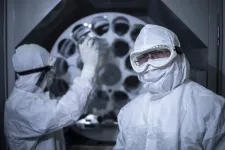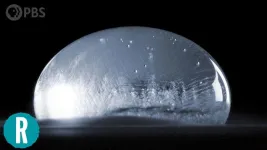(Press-News.org) ITHACA, N.Y. -- Collaborating on a physical object when two people aren’t in the same room can be extremely challenging, but a new remote conferencing system allows the remote user to manipulate a view of the scene in 3D, to assist in complex tasks like debugging complicated hardware.
The system, called SharedNeRF, combines two graphics rendering techniques – one that is slow and photorealistic, and another that is instantaneous but less precise – to help the remote user experience the physical space of the collaborator.
“This would be a paradigm shift,” said Mose Sakashita, a doctoral student in the field of information science who developed the system. “It would enable people to work on tasks that have never been possible and that are very difficult to convey through video-based systems with only one angle.”
Sakashita designed the remote conferencing tool as an intern at Microsoft in 2023, working with Andrew Wilson ’93, formerly a computer science major at Cornell. Sakashita will present the work, “SharedNeRF: Leveraging Photorealistic and View Dependent Rendering for Real-time and Remote Collaboration,” May 16 at the Association of Computing Machinery (ACM) CHI conference on Human Factors in Computing Systems (CHI’24). The paper received an honorable mention.
“When performing a task involving physical objects, such as fixing a kitchen faucet or assembling a circuit, today's video conferencing systems are pretty clunky,” Wilson said. “Lately, there has been a burst of innovation in computer graphics and rendering techniques. SharedNeRF is among the first explorations of using these techniques to address problems that arise when showing more than talking heads.”
Sakashita’s graduate research in the lab of François Guimbretière, professor of information science in the Cornell Ann S. Bowers College of Computing and Information Science and the multicollege Department of Design Tech, focuses on developing new technology to support remote collaboration.
SharedNeRF takes a novel approach to remote collaboration by employing a graphics rendering method called a neural radiance field (NeRF). NeRF uses artificial intelligence to construct a 3D representation of a scene using 2D images. It creates incredibly realistic depictions – complete with reflections, transparent objects and accurate textures – that can be viewed from any direction.
In the SharedNeRF system, the local collaborator wears a head-mounted camera to record the scene. The resulting images feed into a NeRF deep learning model, which renders the scene in 3D for the remote collaborator, who can rotate the viewpoint as desired.
When the scene changes, it triggers the NeRF model to update the view. This update takes some time, however – about 15 seconds – so Sakashita’s team merged the detailed visuals created by NeRF with point cloud rendering, a faster technology. The head-mounted camera and a second RGB-D camera, which detects color and depth, set up opposite the user, capture the scene as a collection of points in space. The method can rapidly convey dynamic parts of the scene, like moving hands.
By merging the two rendering techniques, a remote user can view the scene from various angles in high quality through NeRF while also seeing real-time movements in the scene through point clouds.
SharedNeRF also shows an avatar of the local collaborator’s head, so the remote user can see where they are looking.
Seven volunteers tested SharedNeRF by performing a collaborative flower-arranging project with a partner. When compared with a standard video conferencing tool, or just point cloud rendering alone, five of the volunteers preferred SharedNeRF. All agreed that the system helped them see the design’s details and gave them better control over what they were seeing.
“We found that people really appreciated that they can independently change the viewpoint,” Sakashita said. Many also enjoyed being able to zoom in and out on the flower arrangement and not having to explain to the local collaborator which view they wanted to see.
Currently, SharedNeRF is designed only for one-on-one collaboration, but the researchers envision that it could be extended to multiple users. The technology could also be used to record and archive events, such as educational demonstrations or surgeries, so that students can re-watch from different angles.
Sakashita said future work would be necessary to improve the image quality and to offer a more immersive experience through virtual reality or augmented reality techniques.
-30-
END
3D video conferencing tool lets remote user control the view
2024-05-06
ELSE PRESS RELEASES FROM THIS DATE:
The Ottawa Hospital is expanding life-saving biotherapeutics research and manufacturing to its new campus thanks to $59 million grant
2024-05-06
The Ottawa Hospital is receiving $59 million to boost Canada’s capacity to develop and manufacture life-saving biotherapeutics, including vaccines, gene therapies and cell therapies. Most of the funding ($47 million) will support the construction and operation of a world-class biomanufacturing facility at The Ottawa Hospital’s new campus, while the remainder will enable harmonization and cooperation across six Canadian biomanufacturing facilities.
The funding is part of a $115 million investment from the Government of Canada in the Canadian Pandemic ...
Early neurodevelopmental assessments for predicting long-term outcomes in infants at high risk of cerebral palsy
2024-05-06
About The Study: The results of this study support the potential to identify cerebral palsy and its severity as early as corrected age 3 to 4 months through early neurodevelopmental assessments, but the role of these tests is limited in identifying cognitive and neurodevelopmental impairments.
Authors: Abdul Razak, M.D., of Monash University in Melbourne, Australia, is the corresponding author.
To access the embargoed study: Visit our For The Media website at this link https://media.jamanetwork.com/
(doi:10.1001/jamanetworkopen.2024.9053)
Editor’s ...
Snowfall and drought: $4.8 million field campaign will improve forecasts in western US, led by U-M
2024-05-06
Images
A new science expedition in Yampa Valley, Colorado, will improve forecasts of snowfall and estimates of how climate change will impact snowpack and water availability in the western U.S. mountains, funded with $4.8M from the National Science Foundation.
The field campaign, led by the University of Michigan, brings together scientists from the University of Washington, University of Wisconsin, University of Utah, Colorado State University and Stony Brook University. The team will use an extensive suite of radars and snow-sampling instruments to measure the size and shape of snowflakes and aerosols. ...
SwRI Workbench for Offline Robotics Development™ (SWORD™) launched at Automate 2024
2024-05-06
SAN ANTONIO — May 6, 2024 – Southwest Research Institute is simplifying robotics programming with a new toolkit that embeds computer-aided design (CAD) into robotics motion planning, modeling and execution. The SwRI Workbench for Offline Robotics Development™ (SWORD™) features a user-friendly graphical interface to demystify the fundamental coding required in robot operating system (ROS) application development.
Informed by the Institute’s role in supporting the ROS-Industrial community, SwRI developed ...
Science doesn't understand how ice forms (video)
2024-05-06
WASHINGTON, May 6, 2024 — This video contains incredible macro footage of supercooled water droplets nucleating ice. All George wanted to do was make a crystal-clear ice cube. Instead, he ended up rediscovering dendritic crystal growth, a beautiful phenomenon first described in the 17th century. You’ll never look at your freezer the same way again. https://youtu.be/24TB1vPuzIU?feature=shared
Reactions is a video series produced by the American Chemical Society and PBS Digital Studios. Subscribe to Reactions at http://bit.ly/ACSReactions and ...
Study reveals APOE4 gene duplication as a new genetic form of Alzheimer's disease
2024-05-06
Researchers from the Research Area on Neurological Diseases, Neuroscience, and Mental Health at the Sant Pau Research Institute, led by Dr. Juan Fortea, Director of the Memory Unit of the Neurology Service at the same hospital, have found that over 95% of individuals over 65 years old who have two copies of the APOE4 gene -APOE4 homozygotes- show biological characteristics of Alzheimer's pathology in the brain or biomarkers of this disease in cerebrospinal fluid and PET scans.
The study, published today in Nature Medicine, also concludes that those individuals homozygous for APOE4 also develop ...
Study highlights key predictors of adolescent substance use; special issue of the American Journal of Psychiatry focuses on substance use disorders
2024-05-06
NEW YORK, May 6, 2024 – New research, published online today in the American Journal of Psychiatry, examined a broad range of potential predictors of substance use among adolescents and found sociodemographic variables were the most robust predictors of substance use initiation.
The study is part of a special issue of the journal highlighting advances in understanding the neurobiology and sociodemographic underpinnings of substance use disorders and how this understanding has advanced recognition and treatment. Several authors discussed this work today at a special briefing during the 2024 Annual Meeting of the American Psychiatric ...
Racial and ethnic disparities in initiation of direct oral anticoagulants among Medicare beneficiaries
2024-05-06
About The Study: In this cohort study of Medicare patients with atrial fibrillation, Black and Hispanic patients were less likely to initiate direct oral anticoagulants for atrial fibrillation, although these differences diminished over time. Identifying the factors behind these early disparities is crucial for ensuring equitable access to novel therapies as they emerge for Black and Hispanic populations.
Corresponding Authors: To contact the corresponding authors, email Kamika R. Reynolds, M.S., Ph.D. (kreynolds@ifh.rutgers.edu) and Chintan ...
Behavioral interventions to improve breast cancer screening outreach
2024-05-06
About The Study: These findings show that text messaging women after initial breast cancer screening outreach via either electronic portal or mailings, as well as bulk ordering with or without text messaging, can increase mammogram completion rates.
Corresponding Author: To contact the corresponding author Shivan J. Mehta, M.D., M.B.A., M.S.H.P., email shivan.mehta@pennmedicine.upenn.edu.
To access the embargoed study: Visit our For The Media website at this link https://media.jamanetwork.com/
(doi:10.1001/jamainternmed.2024.0507)
Editor’s Note: Please see the article for additional information, including other authors, author contributions ...
Venus has almost no water. A new study may reveal why
2024-05-06
Planetary scientists at the University of Colorado Boulder have discovered how Venus, Earth’s scalding and uninhabitable neighbor, became so dry.
The new study fills in a big gap in what the researchers call “the water story on Venus.” Using computer simulations, the team found that hydrogen atoms in the planet’s atmosphere go whizzing into space through a process known as “dissociative recombination”—causing Venus to lose roughly twice as much water every day compared to previous estimates.
The team will publish their findings May 6 in ...




